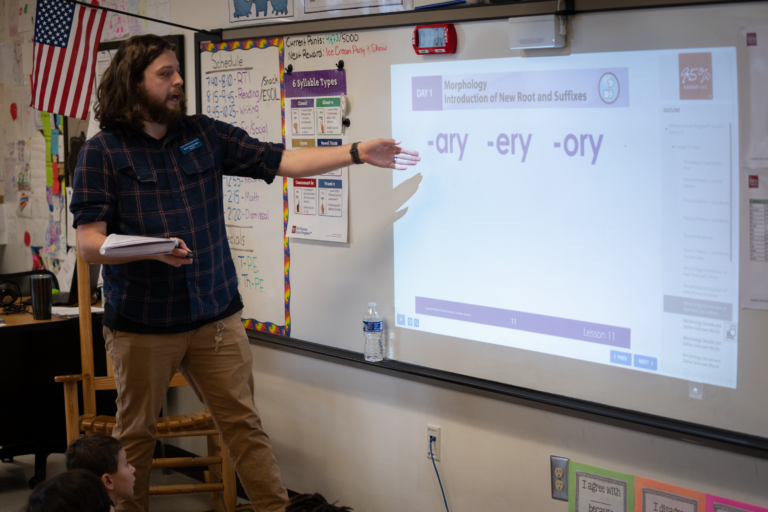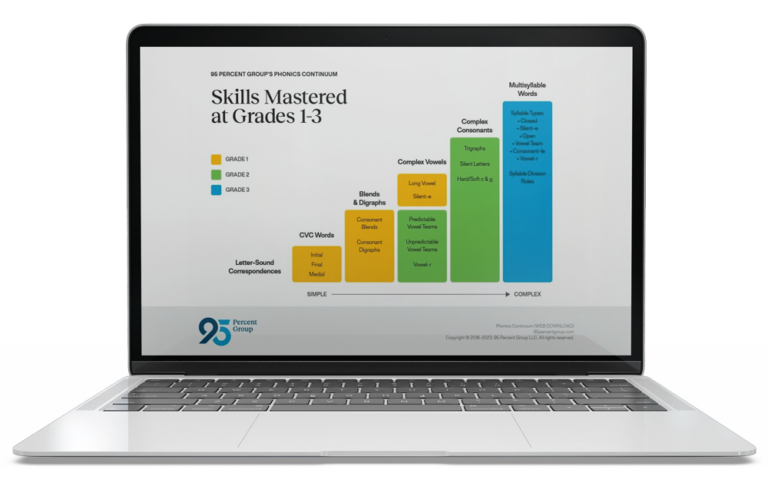Phonological awareness activities and lessons

We’ve written this brief guide to help educators recognize and avoid a few of the most common pitfalls in teaching Phonological Awareness. PA skills need to be taught in a specific sequence from easiest to most complex. Explore a few tips and our Phonological Awareness Continuum to help you support all your students in becoming strong readers.
Phonological Awareness (PA) focuses on sounds. Effective phonological awareness activities require students to orally practice hearing, producing, and manipulating sounds. At 95 Percent Group we recommend that students master segmenting the sounds in spoken words—phoneme segmentation—before adding print.
Research shows that young children gain awareness of syllables before phonemes. This finding is the basis of our recommendation, especially for ELLs and those who struggle with PA, that skills should be taught in a sequence from easiest to most complex. PA instruction begins with the segmentation and blending of syllables in compound words before non-compound words, then moves to onset-rime, and finally phonemes.
Typical instructional pitfalls
Over the past several years, we have observed teachers using phonological awareness activities or games as the core of their intervention instruction. There is a valuable role for activities in providing practice once students have been taught a skill. What’s missing is the explicit teaching of a specific skill before introducing a supplemental activity.
Too often modeling is not complete enough with instruction leaping from an “I Do” to a “You Do” without a “We Do” during which students can attempt portions of the task together with the teacher. As a result, at-risk students continue to struggle.
A second observation we’ve made is that often manipulatives are given to students too early in the instructional cycle, resulting in students being distracted from learning the task. Educators have experienced that moment of realizing that once the students have the manipulatives in hand, their attention shifts away from watching the teacher.
A third issue is that often lessons include a mixture of phonological levels such as jumping from syllable to phoneme to onset-rime all in a single session. We created the Basic Phonological Awareness Continuum to show PA skills in order—from simple to complex.
Tips for instructional scaffolds for teaching Phonological Awareness

It’s important to scaffold students as they work to acquire each skill. Here’s a short list of tips to provide additional support when using the I DO, WE DO, and YOU DO instructional model.
- Position yourself so that students can clearly see your mouth.
- Let them know that watching your mouth will actually help their ears to “hear” the sounds better.
- Make sure that you are able to see their mouths as well. This will help you to tune in to errors much more easily and to provide the appropriate redirection.
- If students are struggling to hear all of the sounds in the word, ask them to watch as you slooooowly stretch the word so that they can see your mouth shift with each sound. After letting them try this, finger stretch the sounds for them. Repeat after the modeling.
Phonological Awareness Lessons™
95 Percent Group’s Phonological Awareness Activities include a series of 39 lessons providing teachers with instructional procedures to explicitly teach skills to students who have not attained sufficient levels of phonological awareness. Program highlights include:
- Sequenced lessons—from the simplest syllable skills with compound words to the most complex phoneme substitution tasks
- Explicit, systematic, scaffolded instruction to assist struggling students
- The introduction of manipulatives at the appropriate time to help make abstract concepts more concrete
- Early lessons begin with pictures, move to shapes, and then end with oral production of the skill
- As the lessons progress, pictures are no longer used and students instead are taken directly to shapes
- Mastery is determined through oral-only production of the skill
Download a sample lesson now to learn more about The Phonological Awareness Lessons™ and how to effectively reach struggling readers in your classroom.



